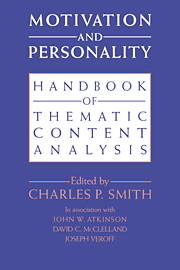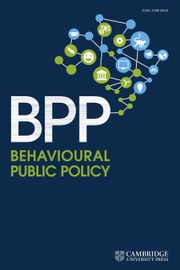Motivation and Personality
Motivation and Personality is the first book to be devoted primarily to content analysis systems for assessment of characteristics of the individuals, groups, or historical periods that create verbal materials.
Part I discusses general issues including the merits of content analysis and its relation to other contemporary methods of motivation and personality assessment, the determinants of thematic apperception and the use of thematic methods in survey research and for the analysis of archival and naturally-occurring verbal materials. Part II presents 14 different coding manuals, each with an introductory chapter, and Part III deals with methodological considerations and materials for learning how to obtain and code verbal materials.
The volume will serve as a handbook for researchers who wish to use content analytic methods for research in personology, experimental psychology, or social science, and also as a reference work providing information about content analytic measures of motives for achievement, affiliation, intimacy, and power, as well as measures of personal causation, conceptual complexity, uncertainty orientation, explanatory style, psychological stances toward the environment, self-definition, and responsibility. The various systems, research regarding the background of the systems, and practice materials are included to create a book that is both reference and handbook.
- First comprehensive book on thematic analysis which includes pictures and analyses
Reviews & endorsements
"...will further entrench thematic approaches in psychological research for years to come...indispenable addition to the library of personality researchers and clinicians." Richard M. Ryan and T. Cameron Wild, Contemprary Psychology
Product details
June 1992Hardback
9780521400527
728 pages
237 × 159 × 47 mm
1.207kg
26 b/w illus. 11 tables
Available
Table of Contents
- Preface
- Acknowledgements
- 1. Introduction: inferences from verbal material
- Part I. General Issues:
- 2. Motivational determinants of thematic apperception
- 3. How do self-attributed and implicit motives differ?
- 4. Thematic analysis, experience sampling, and personal goals
- 5. Motivational configurations
- 6. Thematic apperceptive methods in survey research
- 7. Content analysis of archival materials, personal documents, and everyday verbal productions
- 8. Reliability issues
- Part II. Content Analysis Systems:
- 9. The achievement motive
- 10. A scoring manual for the achievement motive
- 11. The motive to avoid success
- 12. A revised scoring manual for the motive to avoid success
- Part III. Afflilation:
- 13. The affiliation motive
- 14. A scoring manual for the affiliation motive
- 15. The intimacy motive
- 16. The intimacy motivation scoring system
- 17. Affiliative trust-mistrust
- 18. A scoring system for affiliative trust-mistrust
- Part IV. Power:
- 19. Power motivation
- 20. A scoring manual for the power motive
- 21. Power motivation revisited
- 22. A revised scoring system for the power motive
- Part V. Attribution and Cognitive Orientations:
- 23. Personal causation and the origin concept
- 24. The origin scoring system
- 25. Explanatory style
- 26. The explanatory style scoring manual
- 27. Conceptual/integrative complexity
- 28. The conceptual/integrative complexity scoring manual
- 29. Uncertainty orientation
- 30. A manual for scoring need for uncertainty
- Part VI. Psychosocial Orientations:
- 31. Assessing adaptation to life changes in terms of psychological stances toward the environment
- 32. Scoring manual for psychological stances toward the environment
- 33. Self-definition and social definition: personal styles reflected in narrative style
- 34. Revised scoring manual for self-definition and social definition
- 35. Responsibility
- 36. Scoring system for responsibility
- Part VII. Methodology, Scorer Training, Data Collection:
- 37. Methodological consideration: steps in research employing content analysis systems
- Appendixes
- References
- Indexes.








